Related Research Articles
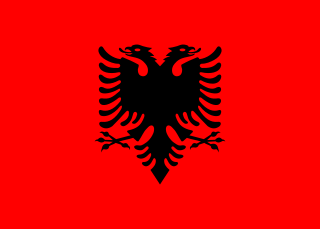
The flag of Albania depicts a silhouetted black double-headed eagle in the center of a red background. The red stands for bravery, strength, valour and bloodshed, while the Eagle represents the sovereign state of Albania. The flag was established as the national flag of Albania when the country gained its independence from the Ottoman Empire in 1912.

The Congress of Lushnjë, historically documented by the name Mbledhja Kombiare Lushnje, was a conference of Albanian political leaders held from January 21 to January 31, 1920, in Lushnjë, Albania.

Shijak is a town and a municipality in Durrës County, west-central Albania. The municipality was formed at the 2015 local government reform by the merger of the former municipalities Gjepalaj, Maminas, Shijak and Xhafzotaj, that became municipal units. The seat of the municipality is the town Shijak. The total population is 27,861, in a total area of 92.24 km2. The population of the former municipality at the 2011 census was 7,568.

The Principality of Albania was a short-lived monarchy in Albania, headed by Wilhelm, Prince of Albania, that lasted from the Treaty of London of 1913 which ended the First Balkan War, through the invasions of Albania during World War I and the subsequent disputes over Albanian independence during the Paris Peace Conference of 1919, until 1925, when the monarchy was abolished and the Albanian Republic declared.

The Albanian Declaration of Independence was the declaration of independence of Albania from the Ottoman Empire. Independent Albania was proclaimed in Vlorë on 28 November 1912. Six days later the Assembly of Vlorë formed the first Government of Albania which was led by Ismail Qemali and the Council of Elders (Pleqnia).

Ferid Vokopola was an Albanian politician, theologist, translator and delegate of Lushnjë in the Assembly of Vlora held on 28 November 1912, and one of the 40 signatories of the Albanian Declaration of Independence.
Zyhdi Ohri, also known as Zuhdi bey Ohri was a 19th-century Albanian patriot, politician, and lawyer. He was a representative of Ohrid and Struga in the Assembly of Vlora held on November 28, 1912, and one of the 40 signatories of the Albanian Declaration of Independence.
Abaz Dilaver Çelkupa or Abaz Efendi Çelkupa was an Albanian politician and one of the delegates and signatories of the Albanian Declaration of Independence in 1912. He was among the key activists of the Albanian National Awakening.
Mustafa Hanxhiu or Mustafa Ali Ibrahimi was a 19th-century Albanian politician. He was one of the delegates of the Albanian Declaration of Independence, where he represented Durrës.
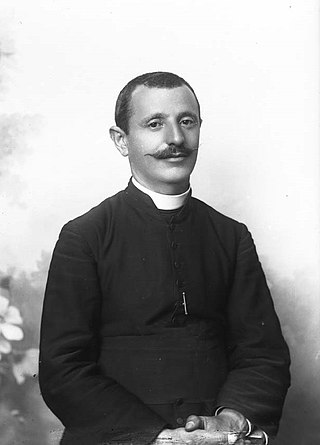
Dom Nikoll Kaçorri, was a prominent figure of the National Renaissance of Albania. A signatory of the Albanian Declaration of Independence, Dom Kaçorri served as Deputy Prime Minister of the Provisional Government of Albania, after the independence.
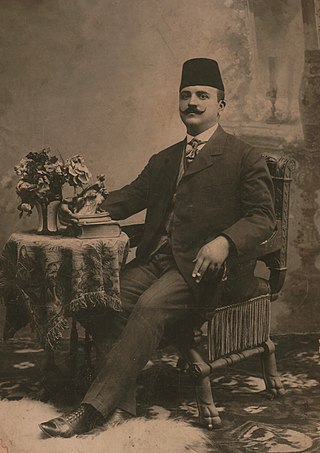
Mufid Bey Libohova was an Albanian economist, diplomat and politician and one of the delegates at the Assembly of Vlorë where the Albanian Declaration of Independence took place. He served as the first Minister of Interior of Albania, during the Provisional Government of Albania. He held different government positions on nine occasions between 1913–1927, holding the positions of Justice Minister, Minister of the Interior, Minister of Finances, and Minister of Culture.

Syreja Vlora (1860–1940), usually referred to as Syrja Bey Vlora, was an Ottoman Albanian politician, an active figure of the Albanian Declaration of Independence in 1912 and one of the delegates of the Assembly of Vlorë.

The All-Albanian Congress, Albanian National Congress, or Albanian Independence Congress was a held in Vlorë on November 28, 1912. Congress participants constituted the Assembly of Vlorë which established Albanian Provisional Government and elected Ismail Qemali as its president.

Independent Albania was a parliamentary state declared in Vlorë on 28 November 1912 during the First Balkan War. Its assembly was constituted on the same day while its government and senate were established on 5 December 1912.
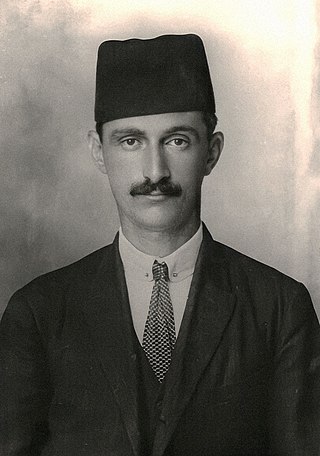
Xhemal Bushati (1880–1941) was an Albanian politician of the twentieth century.

Aqif Pasha Biçaku mostly known as Aqif Pashë Elbasani was an Ottoman Albanian political figure in the Sanjak of Elbasan and after the Young Turk Revolution became an activist for the Albanian national cause.

Marigo Posio was one of the most distinguished Albanian women, an activist of the Albanian National Awakening and Independence Movement, and consolidating the social status of Albanian women. She is mostly remembered for sewing the flag raised by Ismail Qemali during the Albanian Declaration of Independence in Vlorë on 28 November 1912.
The Vrioni were an aristocratic Albanian family and one of the largest landowners of Albania, otherwise known as "Konaqe" or "Oxhaqe", among which the most important are: Vrioni of Berat and Fier, Vloraj of Vlora, Toptani of Tirana, Biçakçinjtë of Elbasan, Dino of Ioannina and Preveza, Vërlaci of Elbasan, Bushatllinjtë of Shkodra, Këlcyrajt of Këlcyra, Markagjonët of Mirdita, etc. Insignia titles held by members of these families, usually Pasha or Bey, corresponded to the assigned positions in the Ottoman administration, central or local, which are given by ferman or berat (decrees) by the Sultan of the Ottoman Empire.
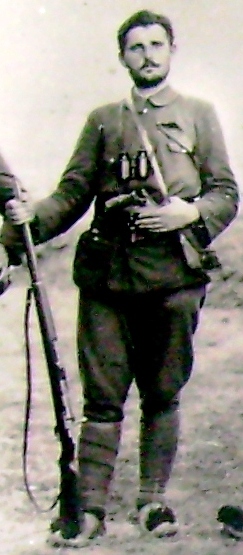
Menduh Zavalani (1889–1914) was an Albanian revolutionary and political leader active during the last years of the Albanian National Awakening. He formed his own revolutionary band and was one of the leaders that liberated Përmet and the environs from the Ottoman Empire. Menduh was an appointed delegate from his hometown Korça to the Albanian National Congress that proclaimed the Independence of Albania. In the intellectual level Menduh was noted for the translation of Friedrich Schiller's drama Wilhelm Tell into Albanian. He was assassinated at a very young age near Pogradec by a local collaborationist band.
Musa Qazimi was an Albanian teacher, mufti, politician, and Turcophile rebel leader. He was first the mayor (1904-1908), then the mufti (1908-1913), and finally the prefect of Tirana (1913-1914). In the turbulent period after the Albanian declaration of independence from the Ottoman Empire, he was first a supporter of the Young Turks, then of Essad Pasha. After he broke with Essad Pasha, he defected and became a leader in the sectarian, reactionary and clerically tinged pro-Ottoman revolt against the new Albanian state's authorities. While the official head of the movement was Haxhi Qamili and the head of its armed forces was Mustafa Ndroqi, Qazimi has been considered to be the ideological inspiration of the movement., and the "real leader" of the uprising. After the revolt was shattered by a makeshift alliance consisting of Mirdita Catholics, local resistance, Kosovar Albanians led by Isa Boletini and some foreign volunteers mainly from Romania, he was found guilty of orchestrating the slaughter that occurred during his revolt against supporters of the Albanian national movement as well as Bektashis and Christians, and he was executed on July 7, 1915.
References
- ↑ "History of Albanian People" Albanian Academy of Science. ISBN 99927-1-623-1
- ↑ Frashëri, Kristo (2008). Shpallja e pavarësisë së Shqipërisë: 28 Nëntor 1912 (in Albanian). Akademia e Shkencave e Shqipërisë. ISBN 978-99956-10-14-2.
- ↑ "Boshnjakët e Shijakut". Gazeta Impakt. 2019-03-23. Retrieved 2020-11-08.
- ↑ "Prefekti i Elbasanit: Ju tregoj gjyshin tim, firmëtarin e Pavarësisë" (in Albanian). Retrieved 2020-11-08.
- 1 2 "Ligjvënësit Shqiptarë (1912-2017) dhe Firmëtarët e Aktit të Pavarësisë" (PDF). Parliament of Albania . p. 49.
- ↑ "Kush ishin 40 firmëtarët e Pavarësisë". Zgjohu Shqiptar. 2018-11-13. Retrieved 2020-11-08.
- ↑ Terziu, Fatmir (16 May 2015). ELBASANI NË ARKIVAT BRITANIKE (in Albanian). Lulu.com. ISBN 978-1-326-27735-2.